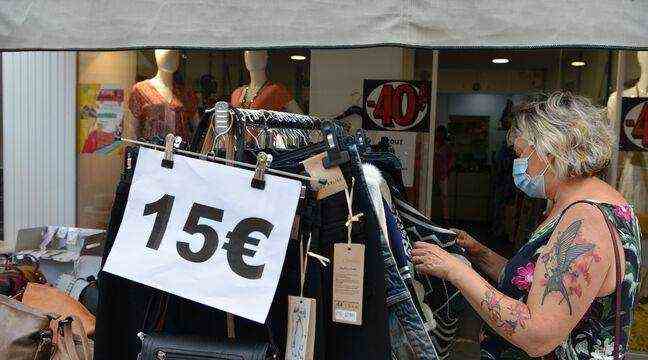While the start of the summer sales, this Wednesday, should give a little boost to consumption, the latter has already started well for a few weeks. Thus, from the end of May to mid-June, bank card payments were 16% higher compared to the same period in 2019, according to the Ministry of the Economy. A strong rebound which coincides with the reopening of shops and terraces on May 19.
Many areas are benefiting from this craze: spending on electronic and IT goods (+ 40% in mid-June compared to 2019), clothing-textiles (+ 33% vs 2019, after a peak of 70% in the first days reopening), but also recreational activities (museums, sports facilities, etc.). “Even in sectors which remain depressed, such as passenger transport, amusement parks, tourist exhibitions or theaters, activity is on the rise markedly”, underlines Bercy.
Savings in stock
“This rebound was expected after weeks of confinement, explains to 20 minutes Anne-Sophie Alsif, chief economist at the Bureau of Economic Information and Forecasts (Bipe). This is a phenomenon that we had already observed last year. Between May and June 2020, household consumption had already been much higher (+ 20%) than the 2019 level. The rebound should continue this summer ”.
The economist recalls in fact that “the French have generally seen their purchasing power preserved thanks to state aid, for example with the financing of short-time working. And with vaccination, the horizon for the next few months is clearing up a bit and could therefore encourage people to use their savings a little more ”.
Unequal hoteliers
Still, the horizon is struggling to emerge in certain sectors, and in particular the hotel and catering industry. For example, it was not until the second week of June – which coincided with the possibility of having a meal indoors – for spending in restaurants to finally exceed their pre-crisis level (+ 11% compared to the same period). of 2019).
For hotels, the recovery is very uneven depending on the region. “Those with the highest occupancy rates are: Pays de la Loire (58% since June 9), Brittany (57%), Center-Val-de-Loire (54%), Nouvelle-Aquitaine (54% ) and Normandy (52%) ”, indicates Bercy. In contrast, the hotels in Ile-de-France are only 36% full, in particular due to the low attendance of international customers.
There are still uncertainties
Despite a rather optimistic finding overall, some economists call for caution on the analysis of this consumption in recent weeks. “Some figures are impressive, but it is because we are in a catching-up effect”, recalls Anne-Sophie Alsif. Indeed, the government regularly praises strong GDP growth expected this year (+ 5%)… but which will not be enough to offset the historic drop in 2020 (- 8.3%). In other words, the French economy has not yet returned to its pre-crisis level, and will only do so in 2022, or even 2023, according to various forecasts.
Of course, Bercy is playing its part by insisting on the most “positive” figures, but we must not forget that the country remains subject to many uncertainties. What will happen, for example, when the State turns off the tap for aid to companies, and some will find themselves in great difficulty, and will have to lay off workers? “This could help limit the rebound in consumption,” by affecting household confidence in the future, says Hélène Baudchon, economist at BNP Paribas interviewed by AFP. Not to mention that the growth forecasts made by the Ministry of the Economy do not take into account a potential fourth wave of contamination, which could occur at the start of the school year. If it were to occur, the rebound in consumption expected this summer could then be halted.

